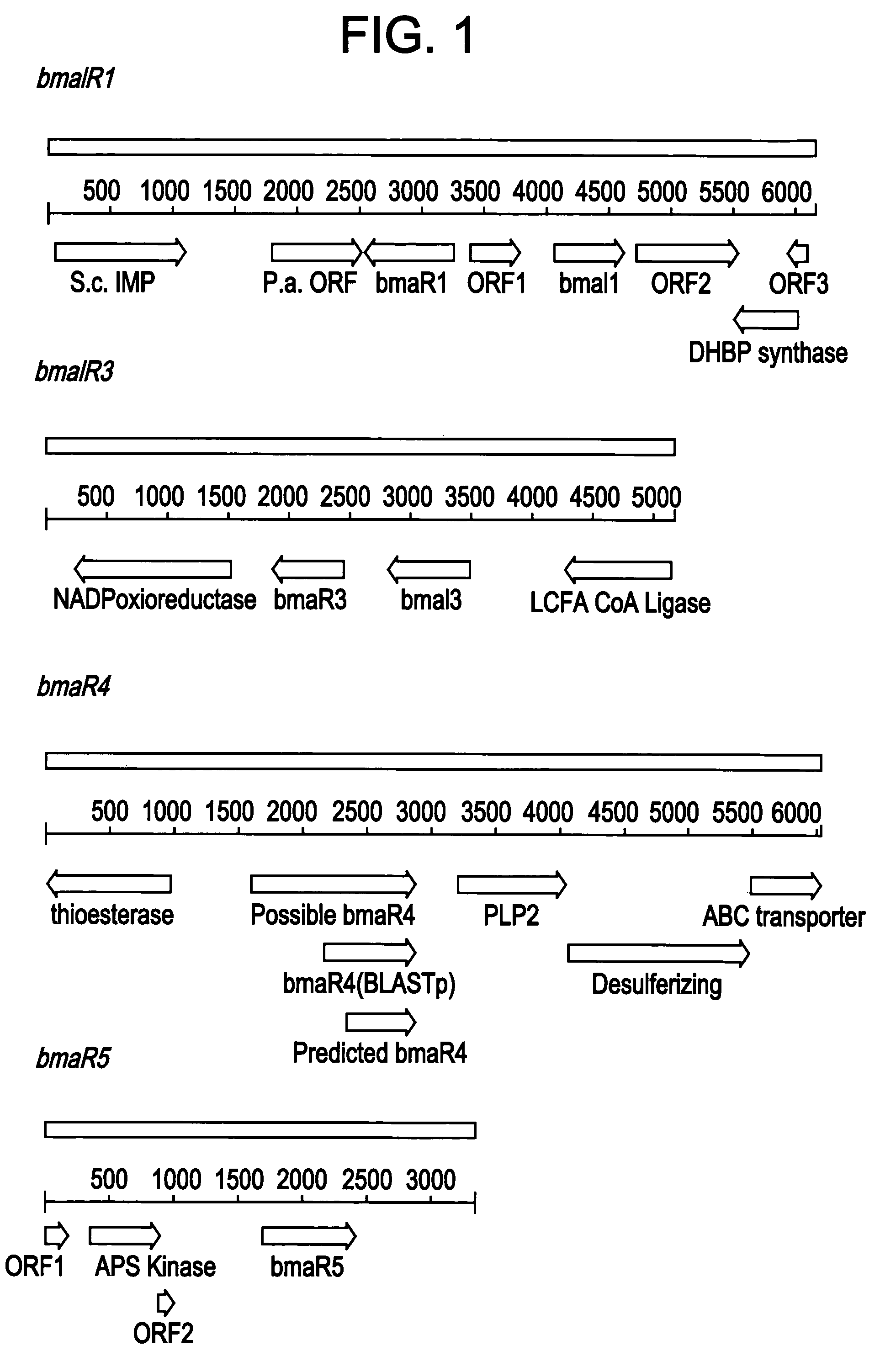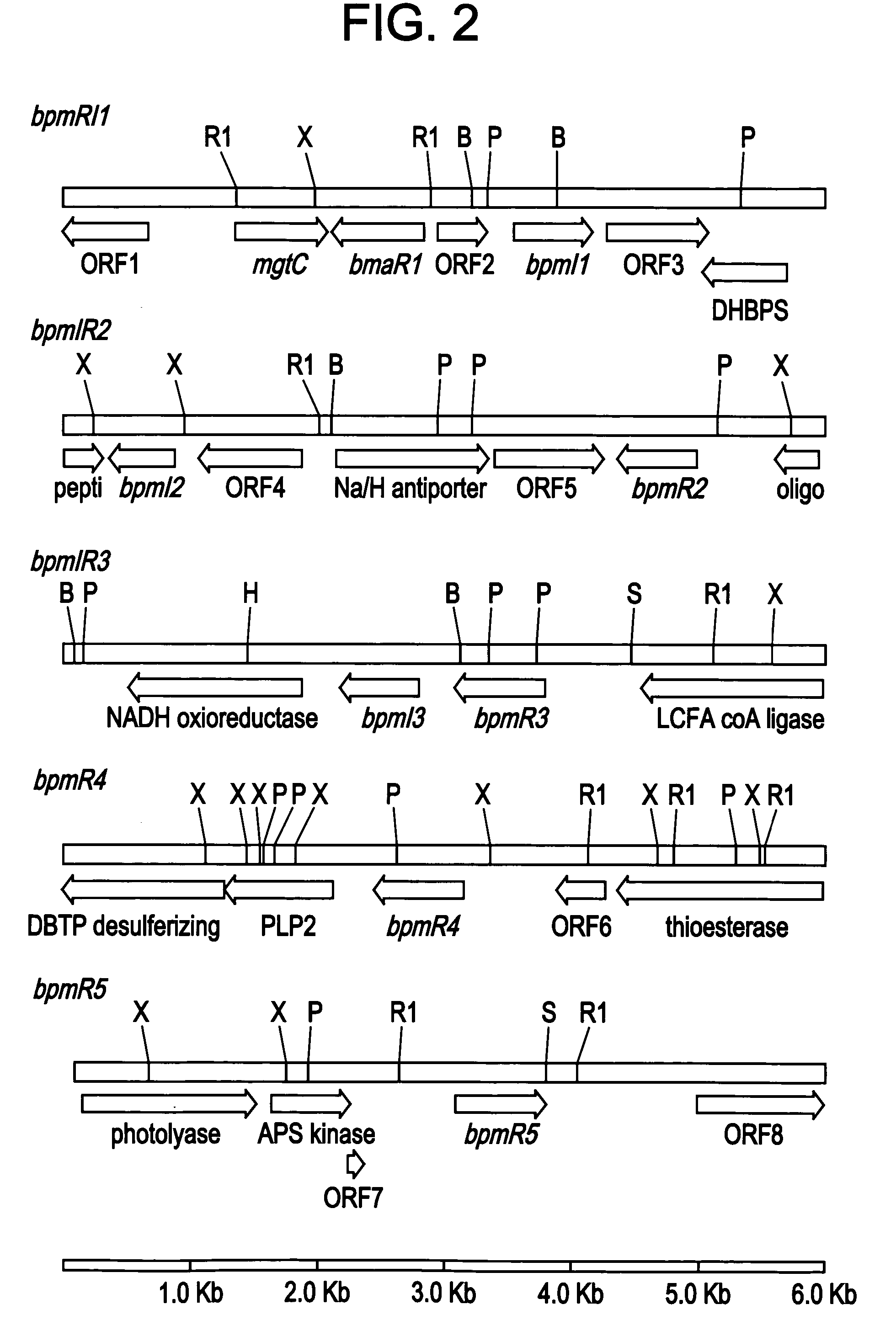Glanders/meliodosis vaccines
a technology of meliodosis and vaccines, applied in the field of glanders/meliodosis vaccines, can solve the problems of weight loss, difficulty in breathing, elevated temperature,
- Summary
- Abstract
- Description
- Claims
- Application Information
AI Technical Summary
Benefits of technology
Problems solved by technology
Method used
Image
Examples
example 1
[0135]Using the cepIR and lasIR genes as digital probes, several AHSs and transcriptional regulators were identified within the K96243 genome. Given the genetic similarity between B. thailandensis DW503 and B. pseudomallei 1026b, only small internal gene amplicons corresponding to each quorum allele were PCR amplified (FIG. 1) and sequenced from each strain. Nucleotide comparisons between the B. thailandensis DW503 and B. pseudomallei 1026b quorum genes demonstrated significant DNA homology (data not shown). PCR amplification and BLASTX search results further confirmed that the B. thailandensis DW503 genome encodes three AHS and five putative transcriptional regulators belonging to the LuxIR family of quorum proteins.
EXAMPLE 2
[0136]Gene Alignments for B. Pseudomallei.
[0137]The identified B. pseudomallei / mallei quorum genes share similarity with AHS and AHL receptors from Burkholderia vietnamiensis, Ralstonia solanaserum, Burkholderia multivorans, and P. aeroginosa. All of the AHS g...
example 2
[0141]B. Thailandensis Quorum Sensing Mutants.
[0142]To assay for hemolysis and / or rhamnolipid biosynthesis, colonies were tooth picked onto 5% sheep blood agar plates and incubated at 37 C for 24-72 hours. Hemolysis was indicated by a clearing of the erythrocytes around the site of inoculation. Analysis of B. thailandensis and the engineered quorum mutants revealed that mutations in bpm::R1, bpm::R2, and bpm::R4 produced zones of hemolysis equivalent to that of wild type DW503. In contrast, mutations in bpm::I1 exhibited slight hemolysis while bpm::I2, bpm::I3, bpm::R3, and bpm::R5 disruptions revealed hyperhemolytic phenotypes with extensive beta hemolysis.
[0143]Twitching and swarming motility were examined using methods described by Reimmann et al. Plates were incubated at 30 C for 48-72 hrs. Mutations in the bpm::I2, bpm::R1, and bpm::R3 loci appeared to induce a defective twitching phenotype. Wild type DW503 colonies display a saucoidal symmetrical morphology without visible pig...
example 3
[0146]Site-specific integration of the internal gene fragment with the target B. mallei gene was confirmed using PCR with whole gene primers. Following recovery and confirmation, the mutants were subjected to a series of in vitro tests to determine which AHL signaling molecules they synthesize. The results of this analysis suggest that the BmaI1 and BpmI1 direct the synthesis of C8-HSL and the bmaI3 and bpmI3 genes encode proteins that produce C6-HSL. In contrast, the B. pseudomallei BpmI2 allows for the biosynthesis of N-decanoyl homoserine lactone. A thin liquid chromatography (TLC) based reporter assay (McClean, K. H. et al., 1997, Microbiology 143, 3703-3711; Zhang, Z. and L. S. Pierson III, 2001, Appl. Environ. Microbiol. 67, 4305-4315) in conjunction with mass spectrometry was used to confirm these results.
[0147]The AHS merodiploids in B. mallei were evaluated in whole body aerosol models (Jeddeloh, J. et al., 2003, Infect. Immun. 71, 584-587).
[0148]Female BALB / c mice were spr...
PUM
| Property | Measurement | Unit |
|---|---|---|
| pH | aaaaa | aaaaa |
| time | aaaaa | aaaaa |
| flow rate | aaaaa | aaaaa |
Abstract
Description
Claims
Application Information
 Login to View More
Login to View More - R&D
- Intellectual Property
- Life Sciences
- Materials
- Tech Scout
- Unparalleled Data Quality
- Higher Quality Content
- 60% Fewer Hallucinations
Browse by: Latest US Patents, China's latest patents, Technical Efficacy Thesaurus, Application Domain, Technology Topic, Popular Technical Reports.
© 2025 PatSnap. All rights reserved.Legal|Privacy policy|Modern Slavery Act Transparency Statement|Sitemap|About US| Contact US: help@patsnap.com



